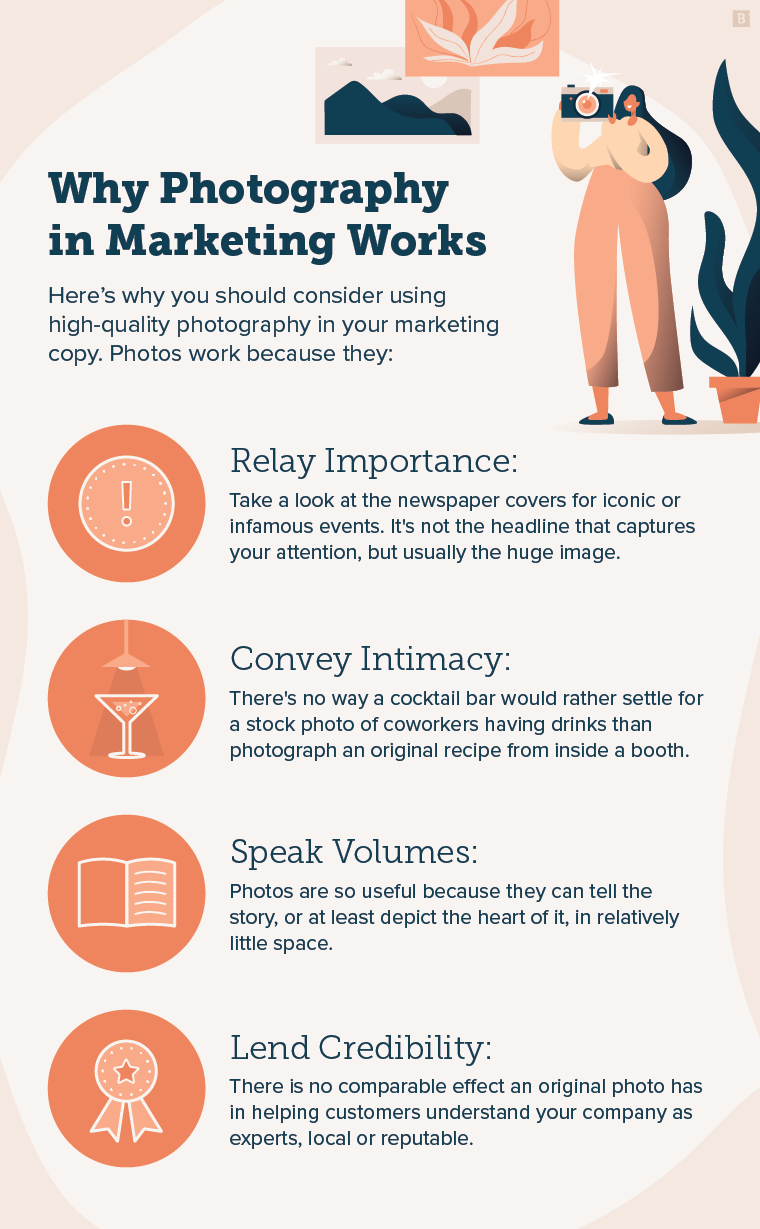Cliches get a bad rep: “don’t judge a book by its cover,” “the early bird catches the worm,” “fighting like cats and dogs,” and so on. You’ve likely heard dozens of these common sayings, as well as been warned off using them altogether. But why? It’s not because they’re not true — if anything, they’re too true.
Consider the cliche “a picture tells a thousand words.” Content marketers ought to take heed, at least, because this seemingly worn-out axiom holds wisdom that applies today. Crafting the highest quality content possible isn’t possible without the pull of visual imagery. Marketing photography is often taken for granted. Yet when focused on and elevated, marketers can add a whole new creative dimension to website content that engages audiences, enhances blog posts, stands out on social media and grabs people’s attention.
The visual element is a powerful one in content. Though it might not have a ton of impact on rankings from search engines, in many ways imagery has become essential to success in some channels, like social media marketing. Images of all kinds are increasingly popular in content, like GIFs in blog posts, infographics, screenshots, memes and videos. Each has a potential use given the content type or the channel — but what we’re focusing on is photography and how you can incorporate it into a marketing strategy. Just take a look at some of our own examples sprinkled throughout.

Here’s what to know about incorporating photos in marketing, plus some photography marketing ideas you can start with.
The Shift Toward More Visual Content
First, let’s look at what the numbers have to say about the use of imagery in content, because they make an incredibly strong case for doing so. It’s already well-known that visuals attract the eye wherever we happen to be, that’s why billboards are still a thing — thanks Shen Yun! What started as a celebration of classical Chinese dancing was advertised to such an extent that social media users started creating memes about their omnipresent billboards.

And while advertising has always been a visual medium, content marketing is starting to catch up. In an analysis of over a million blog posts, Buzzsumo found that articles with an image every 75 to 100 words received 200% more shares than those with fewer images. Visuals on social media are a hot ticket: Facebook posts that include images see more than double the engagement than those without visuals.
With no visuals, there’s no incentive to click: 62% of consumers say that seeing user-generated content or customer photos significantly influences their buying decisions.
Content marketers across industries have gotten the picture and have poured serious marketing efforts into boosting the imagery of blogs and other content forms. In a 2022 survey of marketers by Venngage, 50.5% of marketers said visual content was a core component of their content strategy.
Subscribe to
The Content Marketer
Get weekly insights, advice and opinions about all things digital marketing.
Thank you for subscribing to The Content Marketer!
Content Imagery Extends Beyond Stock Photos
For years, the concept of photography in digital marketing boiled down to the inclusion of cringe-inducing stock photos. While the iPhone and social media platforms like Instagram have certainly changed our notion of photography, the value of an experienced photographer is still undeniable today. Even smartphone images can be elevated through professional post-processing like image background removal to isolate subjects cleanly.
If you work with a local photographer, they will not only create an entirely different atmosphere during the events you share with your audience; they will visually tailor your pictures to your brand and messaging. This can help you create a stronger connection with your target audience during the event and afterward. That’s because you’re catching the emotions of real people.
Even a custom image that may not meet the highest artistic demands can show your creativity and help you stand out from competitors, which is increasingly challenging.
Compared to the thousands of GIFs available or the simplicity of a screen cap, professional photography seems more involved or costly, even if it involves real people. But dedicate some real marketing effort to producing quality imagery and you’ll discover internal photo shoots are low-touch alternatives that work magic. Imagine the quality of photos taken in-house by a boutique versus what the same business could find online. Not only can employees model the clothes they sell in the shop, but snap the photos as well.
Online options, even from niche stock photo vendors who may specialize in fashion, probably can’t come close to the authenticity, artistry and sheer efficiency of internally produced images, which will resonate on a much deeper level with an audience. And at least for now, you won’t be able to adjust AI-generated images to the level you need for consistent branding.
Who knows, a local photography business might even be willing to lend its services in exchange for some marketing help. There’s no substitute for having still images of your products, your people or your place of business. Here’s an example:

It may take some investment — 15% of businesses predict that their budget for visual content creation will increase by 31 to 40 percent, and 10% even believe it will increase by 50%. No matter your niche and what you believe, there is absolutely a place for original photography, whether done by your own staff, a professional partner or Annie freakin’ Liebowitz.
Why Photography for Marketing Works
Before ramping up the visibility of photography in your content, consider its basic advantages. Grasping the fundamentals of why an original photo works better than a white-background stock photo will enable content marketers to concept, design and produce high-quality visuals.

Photos work because they:
- Relay importance: Take a look at the newspaper covers for iconic or infamous events, think natural disasters or presidential elections. It’s not the headline that captures your attention, but usually the huge image that tells you immediately “look here, this is important.” Sure, the tactic sells copies for publishers, but it is also extremely effective as a tool for brand awareness in content marketing.
- Convey intimacy: Half the world is familiar with “Harold,” that bearded, smiling goon of stock photo ignominy. No, we’ll resist the temptation. No Harold meme today. But is there anything worse than a stock model gazing unnervingly and unrelentingly at people from the page? Unlikely. OK, not all stock photos are that bad, but the stiff and contrived feel of most turns off many visitors. Imagine trying to use one on social media. There’s no way a cocktail bar would rather settle for a stock photo of coworkers having drinks than photograph an original recipe from inside a booth. Dim the lights and you’ve created an intimate atmosphere that your Instagram audience can buy into, and which cannot be replicated by many commercial options.
- Speak volumes: Alluding back to that cliche about saying a thousand words, photos are so useful because they can tell the story, or at least depict the heart of it, in relatively little space. Imagery doesn’t have to replace text, but rather summarize or emphasize it, working as a complementary design element in blog posts, case studies, social posts and other content forms. Photos are valuable to the reader who scans or has competing interests, which is just about every target audience these days. Content marketers can use imagery to cut through the noise or cut to the chase — there are another 2 cliches for the grammar Illuminati.
- Lend credibility: Original photos are a no-brainer if a small business really wants to tell an online audience and clientele about itself, its mission, its product and its story. While businesses, like a law firm, health care clinic or auto shop, may certainly be able to find ample stock options, none could probably approach the effect an original photo will have in helping customers understand the company as experts, local or reputable.
4 Photography Marketing Ideas
GIFs, infographics and videos all have a rightful place in the marketing strategy, but their strengths differ. GIFs add humor, while infographics demonstrate knowledge and videos engage users. Photography can blend all these advantages into a single medium, giving content marketers a powerful tool.

But as we’ve discussed, past staid stock photos, many businesses aren’t terribly aware of how they can leverage original photos in their marketing efforts. Here are some ideas to jumpstart your inner shutterbug:
Stage an Internal Product Photo Shoot
Amateur filmmakers have shot whole movies using smartphones and went on to enter them in festivals or otherwise gain acclaim; similarly, there’s nothing stopping businesses from getting high-quality results from lesser resources. Fast food chains spend hundreds on crews to beautify and photograph their offerings, but a catering business doesn’t need all that fanfare, just one or two cooks, a smart device with a camera and some lighting. The approach is comparably lo-fi, but sure to have website visitors salivating over a real menu choice.
Here’s an example from Eric Organization, an Italian caterer, showing one of their amazing dishes:
Partner With a Local Professional Photographer
Bartering with a photography business can achieve a mutually beneficial arrangement wherein content marketers without photography skills or equipment can access such professional services, while perhaps assisting the photo shop with marketing help. Wedding photographers can practice their trade in many other settings, and businesses in need may want to inquire about working out an agreement. Or, venue management firms that host weddings and receptions may be able to forge close ties with photographer partners by referring each other to couples planning their big days.
Bek Smith specializes in wedding prohotography. But she doesn’t limit herself to it. She works with fashion brands, does portrait sessions and even mentors clients on their own photography.
Solicit Pictures From Each Client To Use on Social
Testimonials are powerful assets to increase brand awareness and trust. While a case study might help sway a prospect who’s further down the funnel, think about the impact a social photo essay of sorts could have in increasing your brand profile. Other followers who can see your products being used by real people is a huge co-sign. If you have an expansive following across social networks, tap some of your most avowed brand evangelists for promotional photos, like of their dog with a custom neckerchief or a selfie sporting makeup they ordered. You can also start a social media competition encouraging followers to submit their own photos. Just make sure to get permission to reuse any third party’s photography in content marketing, either in this exact case or any other where use has to be approved.
Whether they’re putting a spotlight on one of their hosts or collaborating with celebrities joining their platform, Airbnb always mixes the scenic beauty of their accommodation offerings with day-in-the-life pictures.
Create the Opportunity To Take Pictures
Those perfect pictures aren’t going to snap themselves. Instead of waiting for that opportunity to present itself, create the chance for photogenic moments by hosting events, getting involved in the community, attending conventions or trade shows, working with other businesses or just being social in any sense. Don’t worry if the environment isn’t perfect; tools like a background removal tool can help transform your images into stunning visuals that truly showcase your brand’s impact and involvement. For instance, the lawn care company that volunteers to help clean up a neighborhood park has the ideal situation to do good, record it and communicate that message visually to a local audience. Either hire a professional photographer to accompany or ask employees and others to help commemorate by taking their own pictures.
Not all event pictures have to be posters of your conference schedule. This post does a great job of opening a discussion on workforce culture while demonstrating expertise as a professional speaker.
Stock Photos: Turning To the Dark Side
As you can see, stock photography isn’t what it used to be, so you really don’t have any excuses to pick the same image of three people at the office over and over. Which platforms you choose is ultimately up to your personal preference and licensing requirements, but we can’t deny that stock images still have their place in content marketing.
As marketers, we’ve already torched stock photography many times up to this point — but in some cases, businesses may have no choice but to use this option. Time is money, and such resources are often scarce; not every small business may be able to pursue photo shoots frequently enough to supply all their visual content needs.
When this last resort must be taken, just know there are stock photo vendors out there that offer quality images. A couple to consider include:
- Twenty20: This vendor is more like the art house of the stock photo scene with a wide library of creative and stunning photos shot in professional and personal settings.
- Unsplash: With similar stock collections to Twenty20, Unsplash can help content marketers add gravitas with a black-and-white portrait or spark the imagination with a scenic countryscape.
- Shutterstock: While you can use Shutterstock’s AI generator, it’s still an amazing stock library for photography, vector graphics, videos and even sound effects.
Websites will have different licensing fees and restrictions on use, however, so it’s crucial you research the terms of business before buying any stock images from any provider. Misuse of copyrighted property could land you in seriously hot legal water — which makes original photography all the more appealing.
Most content marketers know that visuals are great for engagement. But if you really want to connect with a target audience or email list, consider adding original photography in your marketing. Such imagery has high potential to resonate deeply with potential customers, as well as depict your brand in the best possible light.
Editor’s Note: Updated June 2023.





